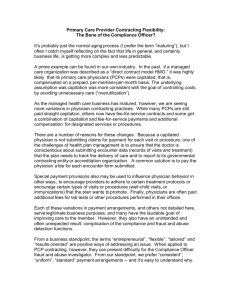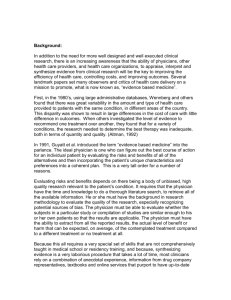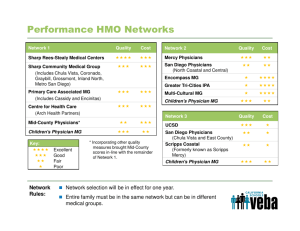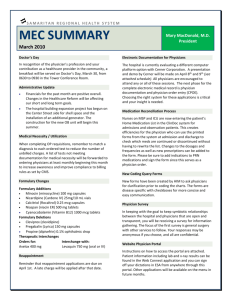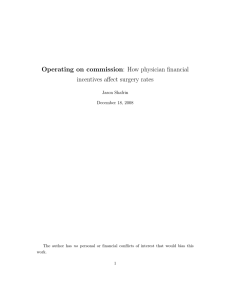M
advertisement
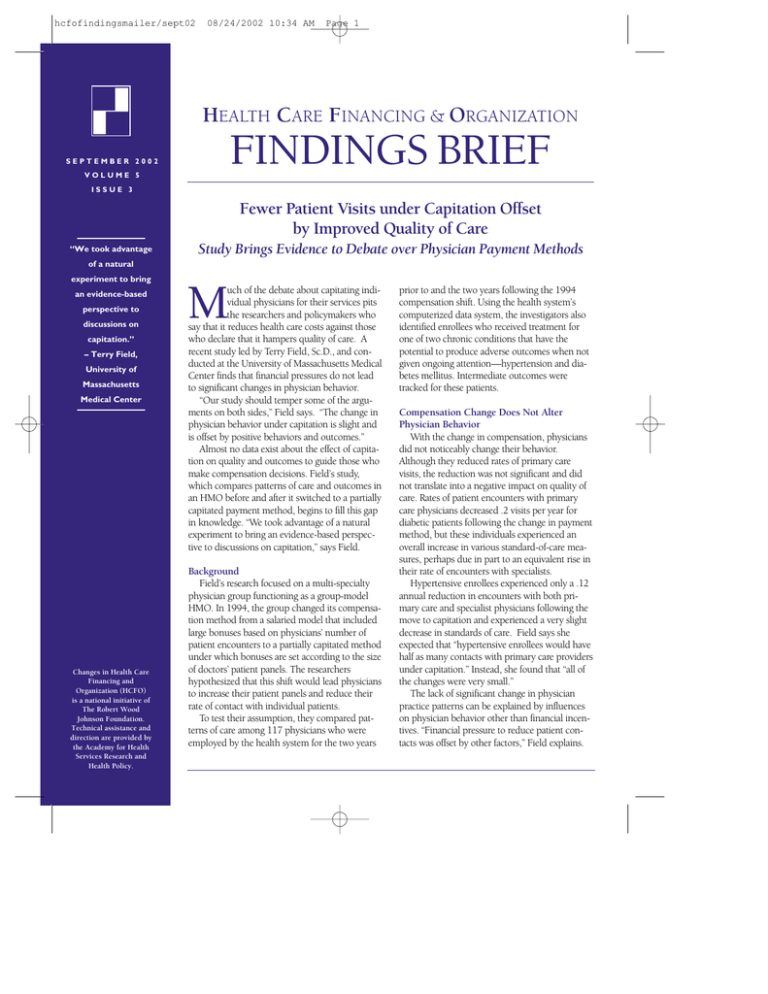
hcfofindingsmailer/sept02 08/24/2002 10:34 AM Page 1 HEALTH CARE FINANCING & ORGANIZATION FINDINGS BRIEF SEPTEMBER 2002 VOLUME 5 ISSUE 3 Fewer Patient Visits under Capitation Offset by Improved Quality of Care “We took advantage Study Brings Evidence to Debate over Physician Payment Methods of a natural experiment to bring an evidence-based perspective to discussions on capitation.” – Terry Field, University of Massachusetts Medical Center Changes in Health Care Financing and Organization (HCFO) is a national initiative of The Robert Wood Johnson Foundation. Technical assistance and direction are provided by the Academy for Health Services Research and Health Policy. M uch of the debate about capitating individual physicians for their services pits the researchers and policymakers who say that it reduces health care costs against those who declare that it hampers quality of care. A recent study led by Terry Field, Sc.D., and conducted at the University of Massachusetts Medical Center finds that financial pressures do not lead to significant changes in physician behavior. “Our study should temper some of the arguments on both sides,” Field says. “The change in physician behavior under capitation is slight and is offset by positive behaviors and outcomes.” Almost no data exist about the effect of capitation on quality and outcomes to guide those who make compensation decisions. Field’s study, which compares patterns of care and outcomes in an HMO before and after it switched to a partially capitated payment method, begins to fill this gap in knowledge. “We took advantage of a natural experiment to bring an evidence-based perspective to discussions on capitation,” says Field. Background Field’s research focused on a multi-specialty physician group functioning as a group-model HMO. In 1994, the group changed its compensation method from a salaried model that included large bonuses based on physicians’ number of patient encounters to a partially capitated method under which bonuses are set according to the size of doctors’ patient panels. The researchers hypothesized that this shift would lead physicians to increase their patient panels and reduce their rate of contact with individual patients. To test their assumption, they compared patterns of care among 117 physicians who were employed by the health system for the two years prior to and the two years following the 1994 compensation shift. Using the health system’s computerized data system, the investigators also identified enrollees who received treatment for one of two chronic conditions that have the potential to produce adverse outcomes when not given ongoing attention—hypertension and diabetes mellitus. Intermediate outcomes were tracked for these patients. Compensation Change Does Not Alter Physician Behavior With the change in compensation, physicians did not noticeably change their behavior. Although they reduced rates of primary care visits, the reduction was not significant and did not translate into a negative impact on quality of care. Rates of patient encounters with primary care physicians decreased .2 visits per year for diabetic patients following the change in payment method, but these individuals experienced an overall increase in various standard-of-care measures, perhaps due in part to an equivalent rise in their rate of encounters with specialists. Hypertensive enrollees experienced only a .12 annual reduction in encounters with both primary care and specialist physicians following the move to capitation and experienced a very slight decrease in standards of care. Field says she expected that “hypertensive enrollees would have half as many contacts with primary care providers under capitation.” Instead, she found that “all of the changes were very small.” The lack of significant change in physician practice patterns can be explained by influences on physician behavior other than financial incentives. “Financial pressure to reduce patient contacts was offset by other factors,” Field explains. hcfofindingsmailer/sept02 08/24/2002 10:34 AM “Because the size of their patient panels directly affects compensation under capitated models, physicians have an incentive to retain patients by providing high quality health care,” says Field. In addition to the financial motivation, physicians feel personal and professional pressure to keep patients. “When a physician has been assigned a patient, he or she takes full responsibility for that person’s overall care,” says Field. Patients’ level of contact with physicians was assessed by counting their number of ambulatory office visits to both primary care providers and specialists for each six-month period over the four-year time frame of the study. For enrollees with diabetes, standards of care were assessed by the patients’ number of annual visits to their primary care physician, podiatrist, and ophthalmologist and the rate at which they were tested for glycemic control. Standards of care for hypertensive enrollees were evaluated by tracking the pre- and post-conversion frequency with which diuretic medications were dispensed and the rate of lipid and potassium testing among those taking diuretic drugs. For both populations, outcomes were evaluated based on the total rate of emer- Page 2 gency room visits and hospitalizations and numbers of stroke or myocardial infarction during the two years before and after the shift in compensation. Outcomes measures were not consistent over the four years of study. Although diabetic patients did have higher rates of emergency room visits and hospitalizations post-conversion, they did not show a change in numbers of acute events such as stroke and myocardial infarction. Hypertension patients showed no increase in emergency room visits or hospitalizations. The researchers controlled for potential confounding factors in their study. “We realized the need to account for patient-level variables,” notes Field. For each year, enrollees’ age, gender, general health status, and co-morbidities were incorporated into the analysis. Field’s study shows that shifting some of the financial liability to the physician level does not have as severe of an adverse effect on patient care and outcomes as critics posit. “The impact of capitating physicians for their own services is not likely to be as dramatic as either critics or proponents suggested,” Field concludes. ■ For further information, please contact Terry Field, D.Sc., at Terry.Field@meyersprimary.org. HCFO FINDINGS BRIEF SEPTEMBER 2002 1801 K Street, NW Suite 701-L Washington, DC 20006 Tel: 202-292-6700 Fax: 202-292-6800 Web: www.hcfo.net E-mail: HCFO@ahsrhp.org Program Director Anne K. Gauthier Deputy Director Deborah L. Rogal Senior Research Manager Jason S. Lee, Ph.D. Editor Christina E. Folz Writer Catherine V. Eikel
